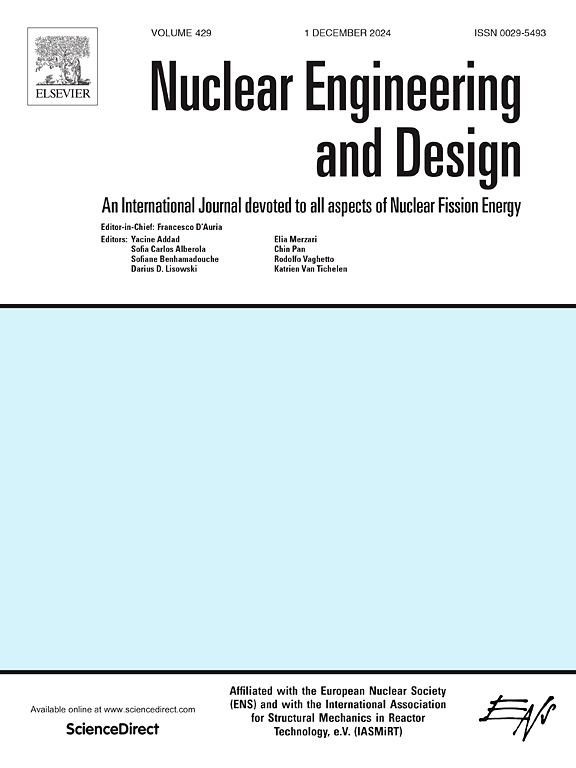Development of a novel neutron-gamma spectrum-based composite material optimization process for the shielding design of a space reactor
IF 1.9
3区 工程技术
Q1 NUCLEAR SCIENCE & TECHNOLOGY
引用次数: 0
Abstract
In this work, a Neutron and Gamma Spectrum-based Composite-gradient-shielding-material Optimization Process (NG-SCOP) has been developed to optimize the shadow shield design of a typical unmanned lithium-cooled small space reactor. This process has been accomplished by coupling an intelligently designed computational algorithm with NECP-MCX through a MATLAB program in an automated manner. The NG-SCOP algorithm designs an optimized shadow shield by adjusting its materials composition based on the relative contributions of neutrons and gamma dose rates in small incremental thicknesses along the entire shield length. Additionally, at each step, this algorithm homogenizes the optimized material composition from all preceding mesh cells up to that point and designs a single homogeneous composite material for the shadow shield structure. This process is repeated across all mesh cells until the fast neutron flux and silicon gamma dose limits for unmanned space reactors are met. The NG-SCOP technique is initially applied to four composite materials, C2H4-B4C-W, C2H4-B4C-Pb, LiH-B4C-W, and LiH-B4C-Pb by incorporating them in the shadow shield structure and calculating the thicknesses and masses required to attenuate neutron and gamma fluxes and doses to the required limits. The mass and thickness of LiH-B4C-W has been further optimized by replacing tungsten, the dense material used for gamma attenuation, with a mixture of different weight fractions of W, B4C, and LiH. The minimum masses obtained for the cell-wise optimized gradient composite and the homogeneous composite shields for LiH-B4C-W are 628 kg and 592 kg, respectively. The results show that the NG-SCOP algorithm can design a more compact and lightweight shadow shield and can be adopted to design optimized shielding for any nuclear facility, including space and other portable nuclear reactors, using any combination of constituent materials and adjustments against any shielding design criteria.
一种新型中子- γ谱复合材料优化工艺在空间反应堆屏蔽设计中的应用
在这项工作中,开发了一种基于中子和伽马谱的复合梯度屏蔽材料优化工艺(NG-SCOP),以优化典型的无人驾驶锂冷却小型太空反应堆的阴影屏蔽设计。该过程是通过MATLAB程序将智能设计的计算算法与NECP-MCX自动耦合完成的。NG-SCOP算法根据中子和伽马剂量率在整个屏蔽长度上的相对贡献,通过调整材料组成来设计优化的阴影屏蔽。此外,在每一步中,该算法将之前所有网格单元的优化材料组成均匀化到该点,并为阴影屏蔽结构设计一个单一的均匀复合材料。这一过程在所有网格单元中重复进行,直到满足无人空间反应堆的快中子通量和硅γ剂量限制。NG-SCOP技术最初应用于C2H4-B4C-W、C2H4-B4C-Pb、LiH-B4C-W和LiH-B4C-Pb四种复合材料,将它们纳入阴影屏蔽结构,并计算将中子和伽马通量和剂量衰减到所需极限所需的厚度和质量。通过用W、B4C和LiH的不同质量分数的混合物代替用于伽马衰减的致密材料钨,进一步优化了LiH-B4C-W的质量和厚度。优化后的梯度复合材料的最小质量为628 kg,均匀复合材料的最小质量为592 kg。结果表明,NG-SCOP算法可以设计出更紧凑、更轻量化的阴影屏蔽,并可用于任何核设施(包括空间和其他便携式核反应堆)的优化屏蔽设计,使用任何组成材料的组合和针对任何屏蔽设计标准的调整。
本文章由计算机程序翻译,如有差异,请以英文原文为准。
求助全文
约1分钟内获得全文
求助全文
来源期刊

Nuclear Engineering and Design
工程技术-核科学技术
CiteScore
3.40
自引率
11.80%
发文量
377
审稿时长
5 months
期刊介绍:
Nuclear Engineering and Design covers the wide range of disciplines involved in the engineering, design, safety and construction of nuclear fission reactors. The Editors welcome papers both on applied and innovative aspects and developments in nuclear science and technology.
Fundamentals of Reactor Design include:
• Thermal-Hydraulics and Core Physics
• Safety Analysis, Risk Assessment (PSA)
• Structural and Mechanical Engineering
• Materials Science
• Fuel Behavior and Design
• Structural Plant Design
• Engineering of Reactor Components
• Experiments
Aspects beyond fundamentals of Reactor Design covered:
• Accident Mitigation Measures
• Reactor Control Systems
• Licensing Issues
• Safeguard Engineering
• Economy of Plants
• Reprocessing / Waste Disposal
• Applications of Nuclear Energy
• Maintenance
• Decommissioning
Papers on new reactor ideas and developments (Generation IV reactors) such as inherently safe modular HTRs, High Performance LWRs/HWRs and LMFBs/GFR will be considered; Actinide Burners, Accelerator Driven Systems, Energy Amplifiers and other special designs of power and research reactors and their applications are also encouraged.
 求助内容:
求助内容: 应助结果提醒方式:
应助结果提醒方式:


